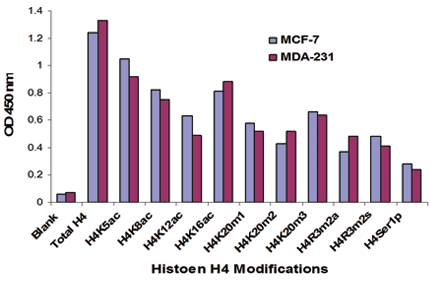·产品描述
组蛋白修饰是一种表观遗传修饰.翻译后的组蛋白修饰包括组蛋白乙酰转移酶介导的组蛋白赖氨酸残基乙酰化,组蛋白去乙酰化酶介导的去乙酰化,组蛋白甲基转移酶介导的赖氨酸和精氨酸的甲基化,组蛋白去甲基化酶介导的去甲基化,组蛋白磷酸化酶可以特定丝氨酸磷酸化,其他的修饰包括泛素化,SUMO化和聚ADP-核酸单位.除了DNA甲基化之外,组蛋白乙酰化和甲基化是最重要的表观遗传标记.有许多已知的人组蛋白H4修饰类型,包括Ser-1 磷酸化, Arg-3甲基化,lysine 5, 8, 12, 和 16乙酰化,lysine 20单、双及三重甲基化.总的来说,常染色质是以组蛋白H4的高乙酰化程度为表征,而此过程是组蛋白乙酰转移酶介导的.组蛋白去乙酰化酶有能力去除这个甲基化标记,从而导致转录抑制.凝聚的异染色质有丰富的H4K20甲基化.H4的赖氨酸残基可以被单、双及三重甲基化,每一种都可以分别调节染色质的结构和转录.此外还有组蛋白的磷酸化修饰,这些修饰可以有不同的组合.以上这些组合形成了一个“组蛋白密码”,可以通过不同的细胞因素进行解读.
EpiQuik组蛋白H4修饰定量试剂盒(比色法)是一组完全的、优化的试剂组合,可以同时定量H4上面10个修饰方式,是一个简单的Elisa检测方法.
·产品特点
1.可以同时测量10种不同的组蛋白修饰,囊括了几乎所有的修饰位点
2. 反应快速,在2.5h内完成
3. 创新的比色法让实验者摆脱了同位素,电泳,色谱或是其他昂贵的仪器
4. .高灵敏度是够检测限达到0.5ng/孔,可检测20ng-500ng/孔的组蛋白提取物
5.含有组蛋白H4对照,可以方便地对组蛋白H4修饰进行定量
6. 含有H4组蛋白标准品,可以对各种样品进行标准化
7. 实验灵活,可以进行单个修饰的处理,也可以进行10个修饰的处理
8. 额外的2条8孔板可以帮助进行上样量的优化,从而使检测结果落在检测限以内(20 ng to 500 ng/孔)
9方案简单,可靠,稳定
| Input Type: | Histone Extracts |
| Research Area: | Histone Methylation |
| Target Application: | Amount Quantitation |
| Vessel Format: | 96-Well Plate |
| 100% Guarantee: | 6 months |
The EpiQuik™ Histone H4 Modification Multiplex Assay Kit (Colorimetric) is a complete set of optimized reagents to detect and quantify nearly all histone H4 modifications (10 different types) simultaneously in a simple, ELISA-like format with use of a standard microplate reader. The kit has the following advantages and features:

Background Information
Histone modifications have been defined as epigenetic modifiers. Post-translational modifications (PTMs) of histones include the acetylation of specific lysine residues by histone acetyltransferases (HATs), deacetylation by histone deacetylase (HDACs), the methylation of lysine and arginine residues by histone methytransferases (HMTs), the demethylation of lysine residues by histone demethylases (HDMTs), and the phosphorylation of specific serine groups by histone kinases (HKs). Additional histone modifications include the attachment of ubiquitin (Ub), small ubiquitin-like modifiers (SUMOs), and poly ADP-ribose (PAR) units. Next to DNA methylation, histone acetylation and histone methylation are the most well characterized epigenetic marks. There are many known sites and types of post-translational modification on human histone H4 that include Ser-1 phosphorylation, Arg-3 methylation, lysine 5, 8, 12, and 16 acetylation and lysine 20 mono-, di-, and trimethylation. Generally, euchromatin is characterized by a high level of histone H4 acetylation, which is mediated by histone acetyltransferases. Histone deacetylases have the ability to remove this epigenetic mark, which leads to transcriptional repression. Condensed heterochromatin is enriched in methylation of H4K20. Lysine residues of histone H4 can be mono-, di-, or trimethylated, each of which can differentially regulate chromatin structure and transcription. Along with other histone modifications such as phosphorylation, this enormous variation leads to a multiplicity of possible combinations of different modifications. This may constitute a “histone code”, which can be read and interpreted by different cellular factors.
Principle & Procedure
The EpiQuik™ Histone H4 Modification Multiplex Assay Kit (Colorimetric) is designed for measuring multiple histone H4 modifications simultaneously. In an assay with this kit, each histone H4 modified at specific sites will be captured by an antibody that is coated on the strip wells and specifically targets the appropriate histone H4 modification pattern. The captured histone modified at specific sites will be detected with a detection antibody, followed by a color development reagent. The ratio of modified histone is proportional to the intensity of absorbance measured by a microplate reader at a wavelength of 450 nm.
Starting Materials
Input materials can be histone extracts or purified histone H4 proteins obtained from human, mouse, rat, as well as a broad range of species including most plants, fungi, and bacteria, based on high sequence homology of histone H4. The amount of histone extracts for each assay can be 20 ng to 500 ng with an optimal range of 50 to 100 ng depending on the purity of histone extracts. The amount of purified histone H4 proteins for each assay can be 1 ng to 25 ng with an optimal range of 4 to 5 ng.

 Fig. 3. Histone extracts were prepared from MCF-7 and MDA-231 cells using the EpiQuik™ Total Histone Extraction Kit (Cat. No. OP-0006) and 10 histone H4 modifications were measured using the EpiQuik™ Histone H4 Modification Multiplex Assay Kit (Colorimetric). 100 ng of total histone proteins per well were used.
Fig. 3. Histone extracts were prepared from MCF-7 and MDA-231 cells using the EpiQuik™ Total Histone Extraction Kit (Cat. No. OP-0006) and 10 histone H4 modifications were measured using the EpiQuik™ Histone H4 Modification Multiplex Assay Kit (Colorimetric). 100 ng of total histone proteins per well were used.
Product Citations
Bhat et. al. (December 2019). The Dopamine Receptor Antagonist TFP Prevents Phenotype Conversion and Improves Survival in Mouse Models of Glioblastoma bioRxiv.
Roy S et. al. (November 2019). Phloroglucinol Treatment Induces Transgenerational Epigenetic Inherited Resistance Against <i>Vibrio</i> Infections and Thermal Stress in a Brine Shrimp (<i>Artemia franciscana</i>) Model. Front Immunol. 10:2745.
Yang L et. al. (May 2018). Differential gene regulatory plasticity between upper and lower layer cortical excitatory neurons. Mol Cell Neurosci.
Kang J et. al. (December 2017). FIH is an oxygen sensor in ovarian cancer for G9a/GLP-driven epigenetic regulation of metastasis-related genes. Cancer Res.